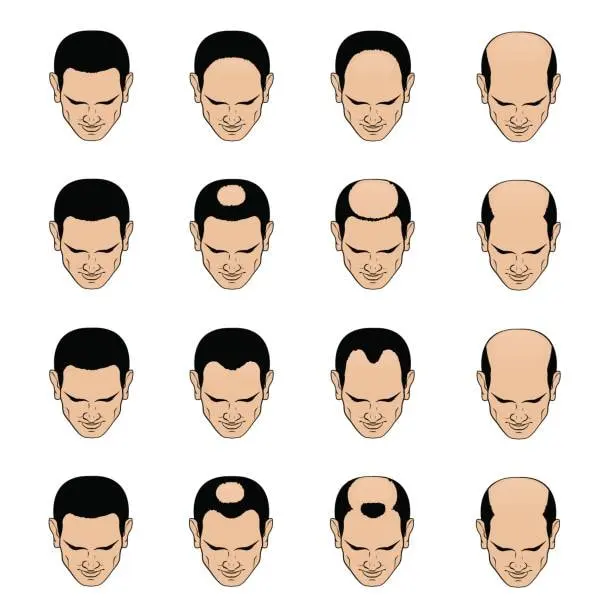The key thing to remember with finasteride is this: it’s best used to stop hair loss before it gets severe. If you still have some thinning hair, finasteride can help thicken it and prevent further loss. But once the hair’s completely gone from an area, no medication can bring it back. It’s a case of “use it before you lose it.” Hair transplants can fill in the gaps, but keeping what you have intact with finasteride is crucial for the long-term.
Some men are concerned about potential side effects, particularly when it comes to sexual drive, “lust” or “libido”. In my years of experience, I’ve found this to be rare among my patients. And if any issues arise, there are ways to manage them. The important thing is not to let fear hold you back from a treatment that could be life-changing. A colleague of mine started using Propecia 25 years ago. Back then, he was 40 and noticed the typical “crown pattern baldness,” with thinning at the corners of his forehead and a growing bald spot on top.

Understanding Hair Loss
What is Androgenetic Alopecia?
Androgenetic alopecia, commonly known as male or female pattern hair loss, is a prevalent condition that affects millions of people worldwide. This type of hair loss is primarily driven by the conversion of testosterone to dihydrotestosterone (DHT), a hormone that causes hair follicles to shrink over time. While it can affect both men and women, it is more frequently observed in men. The condition is hereditary, meaning it can be passed down from your parents. Factors such as hormonal imbalances, stress, and certain medical conditions can also trigger or exacerbate androgenetic alopecia. Understanding this condition is the first step in finding an effective hair loss treatment.
Patterns of Hair Loss
Causes and Types of Hair Loss
Hair loss can be triggered by a mix of genetic, hormonal, and environmental factors. For men, the most common culprit is male pattern baldness, or androgenetic alopecia. This condition is driven by the conversion of testosterone to dihydrotestosterone (DHT), which causes hair follicles to shrink and eventually stop producing hair. Women, on the other hand, often experience female pattern hair loss, which is also influenced by hormonal changes and genetic predisposition. Both types of hair loss can be frustrating, but understanding the underlying causes can help you find the right treatment to slow down or even reverse the process. Treatments like minoxidil can help prevent losing hair and promote regrowth of lost hair.
Genetics and Hormones
Hair Growth Cycle
Medical Management and Hair Regrowth of Hair Loss
Propecia and Hair Growth
Propecia, or finasteride, is a widely used medication for treating androgenetic alopecia in men. It works by inhibiting the enzyme responsible for converting testosterone to DHT, thereby reducing DHT levels in the scalp. This action helps to slow down hair loss and can even promote hair regrowth in some cases. Propecia is taken orally in pill form, usually once a day. It’s important to note that it may take several months to see noticeable results, and continuous use is necessary to maintain hair growth. For many men, Propecia offers a reliable solution to manage hair loss and improve hair density.
Other Treatment Options
Beyond Propecia, there are several other effective treatments for androgenetic alopecia:
- Minoxidil: This topical solution is applied directly to the scalp and works by stimulating hair follicles to promote hair growth. It’s available over-the-counter and is suitable for both men and women.
- Hair Transplantation: A surgical procedure where hair follicles are moved from a donor area (usually the back of the head) to the balding areas. This method provides a more permanent solution to hair loss.
- Low-Level Laser Therapy: This non-invasive treatment uses low-level lasers or light-emitting diodes to stimulate hair growth. It’s a painless option that can be done at home or in a clinic..
- Hair Growth Supplements:: These dietary supplements contain ingredients like biotin, vitamin B, and keratin, which are essential for healthy hair growth. They can be a supportive addition to other treatments.
Peak Masculinity
Starts Here

By Dr. Ryan Welter
August 13, 2025




